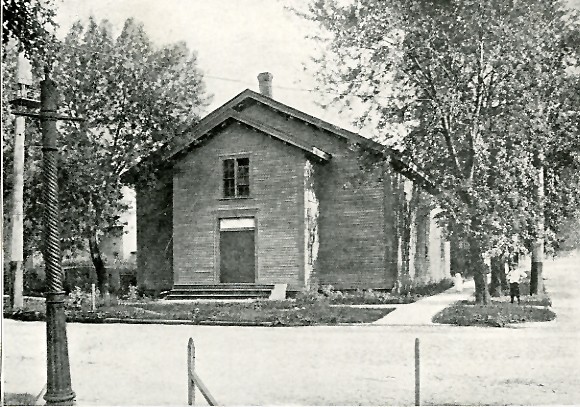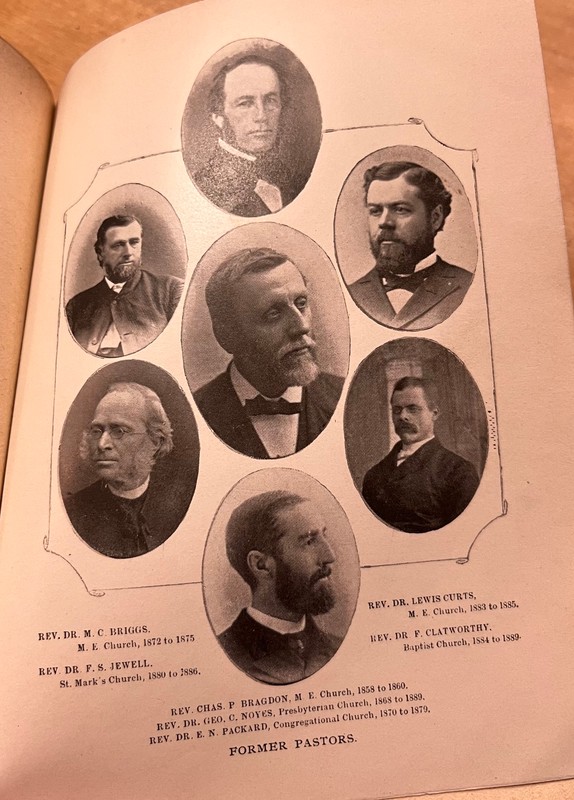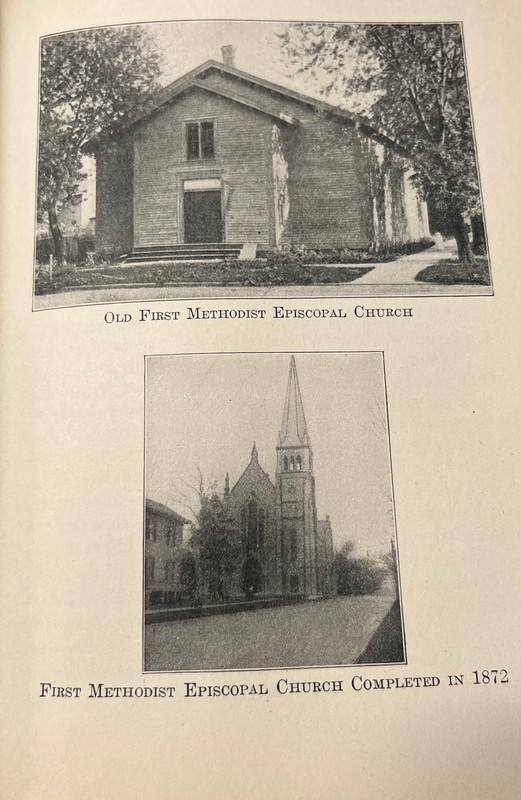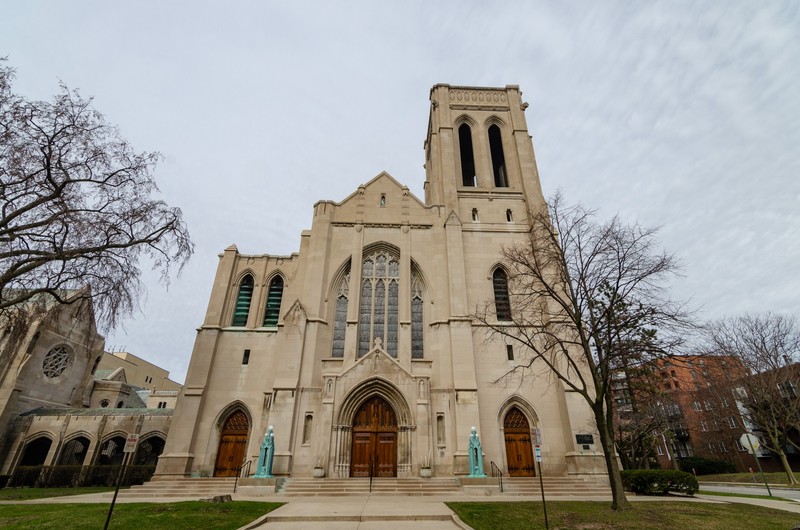First United Methodist Church
Introduction
Author-Uploaded Audio
Listen to a narration of this entry's description by Lori Osborne.
Text-to-speech Audio
Founded in 1854, the original First United Methodist Church building stood on Church Street between Chicago and Orrington Avenues where the Evanston Public Library now stands. Due to its connection to Northwestern University and the founding of Evanston, Frances Willard designated the First United Methodist Church as being the “chief church of Evanston” [1] Willard’s church community was fundamental to the development of her personal faith which in turn, guided her leadership in the temperance and women’s rights movements. Today, First Church continues to be a center of worship in Evanston and strives to uphold their 160+ year “heritage of prophetic preaching, missional outreach, progressive social teaching and action, and a love of music”. [2]
Images
Old First United Methodist Church, circa 1871.

Former Pastors of the First Methodist Episcopal Church

First Methodist Episcopal Church: Old and New Buildings

First United Methodist Church of Evanston Today

Backstory and Context
Text-to-speech Audio
On May 31, 1850, a group of Methodists took the initial steps to found Northwestern University. This same group founded First United Methodist Church and the town of Evanston. Frances Willard describes the history and the prestige of the Methodist Church during her chapter on “Evanston’s Churches” in her book A Classic Town. In addition to highlighting the succession of pastors, Willard underscored its significance to the town of Evanston: “Our Methodist church has always been remarkable for the continuous presence and work of its regularly appointed pastors” [3].
Willard’s faith was an important part of her life, serving as a guide to her personal values and activist work. She regularly evoked prayer and biblical discussions in her journals. Her parents, Josiah Willard and Mary Hill Willard, encouraged daily family prayers, regularly attending Sunday service, and maintaining a strict Sabbath day of rest.
In her autobiography, Glimpses of Fifty Years, Willard explained that her relationship with God did not come naturally to her. Rather, she maintained that “I was not one who naturally took things for granted. It was intuitive with me to seek for causes and for reasons. My faith faculty was not naturally strong….” [4] She was troubled by the inconsistency in her beliefs, but ultimately, she found comfort in knowing that she did not have to have all the answers to have a strong faith. In a journal entry from 1859, she set forth her life intentions: “I have not yet the change of heart that Christ has promised to those who ask Him rightly, but I expect it. I feel inclined to do right more than I ever did before; - it is easy for me to be obliging and patient today, and it was never easy before” [5].
From then on, Willard was an active member at First United Methodist Church. She regularly attended class meetings, revivals, and Sunday services. The church also hosted commencement exercises and church sociables for the surrounding university and community. Willard expressed missing this busy schedule during her travels later in life: “I have felt the loss of church & social religious meetings & our warm hearted temperance gatherings, more than I can say. How true it is that heart warms heart in holy talk along the heavenly way! But I am thankful to have known so much of ‘the assembly of the faithful’ all along the journey now full spent” [6].
After her death in 1898, her memorial service took place at First United Methodist Church’s new building. Willard’s faith influenced her convictions on temperance, social reform, and women’s suffrage in addition to sustaining her through years of illness and activism work.
Sources
[1] Willard, Frances. A Classic Town: The Story of Evanston 1st ed. Chicago, IL: Woman’s Temperance Publication Association, 1892, 137.
[2] "History." First United Methodist Church. Accessed November 29, 2021. https://faithatfirst.com/history/.
[3] Willard, Frances. A Classic Town: The Story of Evanston 1st ed. Chicago, IL: Woman’s Temperance Publication Association, 1892, 127.
[4] Willard, Frances. Glimpses of Fifty Years: 1839-1889 1st ed. Chicago, IL: Woman’s Temperance Publication Association, 1889, 6.
[5] Willard, Frances E. and Carolyn De Swarte. Gifford. Writing Out My Heart : Selections from the Journal of Frances E. Willard, 1855-96 Urbana: University of Illinois Press, 1995, 54.
[6] Willard, Frances E. and Carolyn De Swarte. Gifford. Writing Out My Heart : Selections from the Journal of Frances E. Willard, 1855-96 Urbana: University of Illinois Press, 1995, 387.
Digital image. Frances Willard: A Radical Woman in a Classic Town. https://sites.northwestern.edu/radicalwoman/earlylife/
Willard, Frances. A Classic Town: The Story of Evanston 1st ed. Chicago, IL: Woman’s Temperance Publication Association, 1892, 125
Reeling, Viola Crouch. Evanston: Its Land and Its People 1st ed. Hammond, IN: W.B. Conkey, 1928, 265.
Rogers, Eric Allix. "First United Methodist Church". 2018. Open House Chicago. In First United Methodist Church of Evanston. 2020. Accessed November 28, 2021. https://openhousechicago.org/sites/site/first-united-methodist-church-of-evanston/
